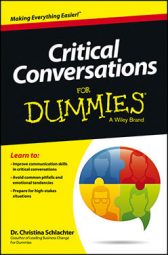Office gossips are insecure, attention seekers who can submarine your efforts. Deter office gossip by skillfully applying your critical conversation skills and stop the rumor mongering in its tracks.
Just like in high school, an office gossiper may feel that her opinions aren’t being listened to, she may be insecure about her abilities, or she may just be looking for attention. Some things never change. But unlike high school, addressing this behavior by focusing on the intention is a much better option than writing something nasty on her locker.
The first step: examine what is happening. The challenge with gossipers is that they often don’t have a specific action that you can observe (hence it’s back-stabbing, not front-stabbing). They may sit quietly, smile, and just agree. Ten minutes after the meeting, they’re telling anyone who will listen how horrible the meeting was, how dismal the project is, or how much they don’t like their teammates (or you).
Here’s how a team member might examine what is happening with the back-stabbing gossiper:
Team member: “I know we agreed in the meeting to all go back to our teams and ask for their input on the type of learning and development they want to see next year to help meet the company goals.
I noticed that you told your employees that learning and development is unnecessary and an added cost to the company. Could I help clarify any of the agreements we made in the meeting?”
Next up: deciding what to do next. What happens next (the decision point) depends on how the information is received. If the recipient of the information replies with, “Oh, no, that isn’t right. I would never say anything like that,” your response could be, “Great. Do you want to schedule a meeting tomorrow to walk through the ideas the team may have?”
Of course, one day the back-stabbing gossiper may say something like this:
Back-stabbing gossiper: “I don’t agree. This whole project is nonsense.”
Team member: “Let’s go back to last week’s meeting. We agreed on the goal, the problem, and the time line. Did something happen to change that agreement?”
In both examples, the examining what is happening focuses on the facts and trying to find out why the back-stabbing gossiper isn’t voicing her concerns in front of other people. Of course, the gossiper may continue with the difficult behavior; in that case, it is time to go back to examining what is happening by stating the problem and then asking for the intention:
Team member: “We’ve been working through this project for six months, and I feel we’ve had some great success with our team discussions. I noticed that you voice your opinions to others after the meeting, and I feel this is going around the process we agreed on. What do you want to accomplish by having conversations that counter the agreements we had just made?”
Using the examine and decide steps should help the recipient of the information understand the impact of their behavior and provides a productive and positive way to help move forward.

